Osho, the Bhagwan
Wild Wild Country is a Netflix
series about Osho - Bhagwan Shree Rajneesh … more
precisely about the Rajneesh movement in Wasco county, Oregon, USA and the
Rajneeshpuram commune there for a few years in the 1980s.
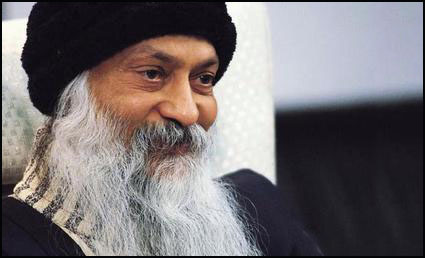
The series portrays a disturbing image of a community mired in contradictions, violence and - in my view - incomprehensible hero (god?) adulation by a bunch of followers who submit to hard labour in order to create a utopian community. Two articles, in the SMH, but especially in The W. Post, tell stories of incredible depravity. But their promised reward was an apparently carefree environment, removed from societal conventions, instead imbued with love, laughter, dancing and ... free sex (Anand Ma Sheela: What do you mean "free sex"? Yes, yes, we don't charge for it).

The show confirms to me the misgivings I used to have about the "Orange People" when they were around in the 1980s; I never liked the herd-mentality at the core of the movement ...
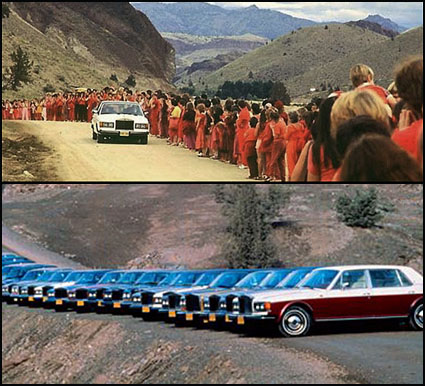
... the adulation of their Bhagwan (= God in Hindi) and the enforced wealth creation, where - similar to the Scientology movement - large donations were necessary, even to the point where people were encouraged to "donate" the proceeds from selling all their worldly goods.

It always was incomprehensible to me that followers would put up with the notion that their Bhagwan needs a Rolls Royce for every day of the year (they got to 93 before the whole thing fell apart).

The Bhagwan - by his own account - indeed was a man of luxury ... he, for instance, accepted a gift of a million-dollar diamond encrusted watch. No free eye operation camps here, no charitable undertakings whatsoever; just watch how the Rajneeshees misused homeless people for their own purposes.
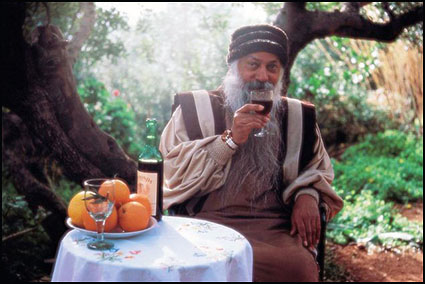
I am very interested in the Netflix series because at the time, in the 1980s - even as late as ten years ago - I was captivated by the Bhagwan's teachings. I bought a book many years ago: The Spiritual Path, Buddha, Zen, Tao, Tantra ...
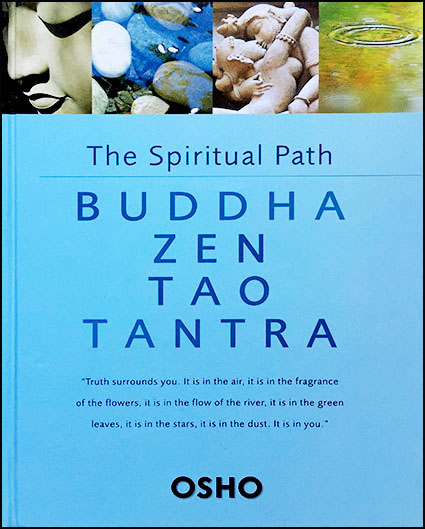
... whose title alludes to the content: It is an amalgamation of four of his books. I look forward to reading it again ... it is brim full of wisdom distilled from his decades long studies on the various religions of the world. The Bhagwan was a professor of philosophy (lecturer of philosophy at Jabalpur University in 1958, promoted to professor in 1960) and an excellent communicator ... but it's just always been his demeanour, his ostentatious robes and his eccentricities that made me repel him (which, undoubtedly, were all attractions for his followers).
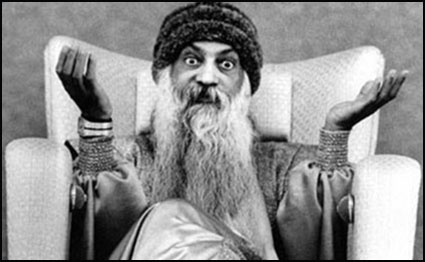
Furthermore, his "dynamic meditation", which contains a strange technique of physicality bordering on violence, always made me suspicious ... its method is so dissimilar to what true meditation is (as per the Osho quote at the end of this blog).
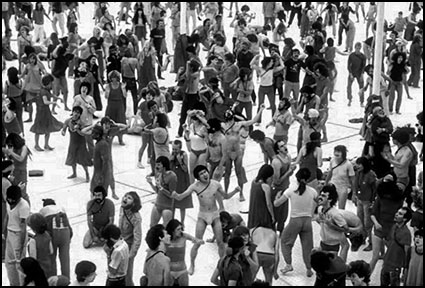
Bhagwan Shree Rajneesh (a.k.a. Osho) is considered one of the most influential "spiritual leaders" of the 20th century (Wikipedia). Rajneesh's syncretic teachings emphasise the importance of meditation, awareness, love, celebration, courage, creativity and humour; they have had a notable impact on Western New Age thought.
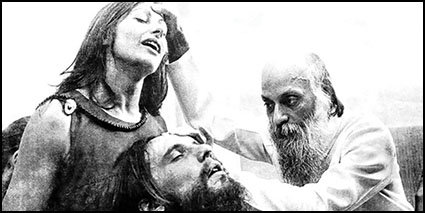
Rajneesh was critical of socialism,
Gandhi and institutional religions. He said that socialism would socialise only
poverty, and he described Gandhi as a masochist reactionary who worshipped
poverty. What India needed to escape its backwardness was capitalism, science,
modern technology and birth control. He criticised orthodox Indian religions as
dead, filled with empty ritual, oppressing their followers with fears of
damnation and the promise of blessings (not unlike Catholicism). Such statements made him controversial,
but also gained him a loyal following that included a number of wealthy
merchants and businessmen.
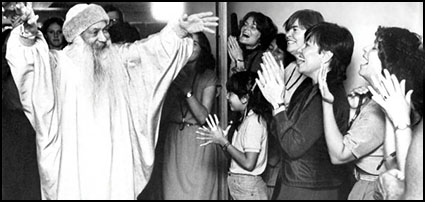
One of the most provocative and
inspiring spiritual teachers of the twentieth century, Osho defies
categorization - reflecting everything from the individual quest for meaning to
the most urgent social and political issues facing society today. His books are
not written but are transcribed from recordings of extemporaneous talks given
over a period of thirty-five years. Osho has been described by the Sunday Times
in London as one of the ‘1000 Makers of the 20th Century’ and by Sunday Mid-Day
in India as one of the ten people - along with Gandhi, Nehru and Buddha - who
have changed the destiny of India.
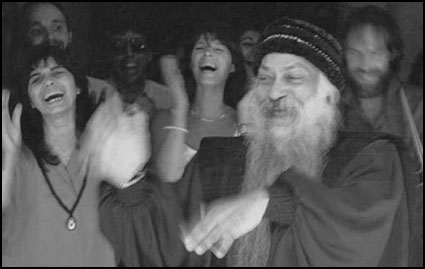
Osho has a stated aim of helping to
create the conditions for the birth of a new kind of human being, characterized
as ‘Zorba the Buddha’ - one whose feet are firmly on the ground, yet whose
hands can touch the stars. Running like a thread through all aspects of Osho is
a vision that encompasses both the timeless wisdom of the East and the highest
potential of Western science and technology. Known for his contribution to the science of inner transformation, the influence of his
teachings continues to grow, reaching seekers of all ages in virtually every
country of the world.
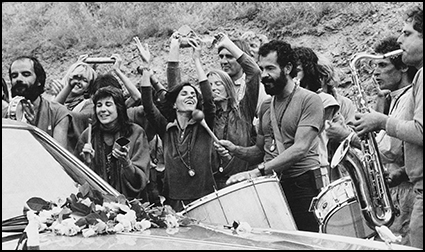
Tellingly, Krishnamurti rejected him (they were contemporaries) ...
"Krishnamurti had no time for Bhagwan, and particularly objected to the use of the word Bhagwan; nobody other than God himself should use that title, he said. Krishnamurti had told Deeksha: I have received thousands of letters from all over the world asking why I do not speak out in public against this man. But I will not, as it is not my way. The man is a criminal. You have to understand this very clearly. What he is doing to people in the name of spirituality is criminal. One must never give to another human being – and he is simply a human being – your ultimate manifestation of consciousness, which is your ability to make decisions for yourself. You have made a great mistake in giving him hat power for twelve years, but understand this: no man has power except the power his followers give him. That is why he needs people around him all the time, and the more the better.” (Quora)
Nevertheless, his popularity has increased markedly since his death. I have added a footnote to my essay MEDITATION 2 in my book en.light.en.ment

Osho Rajneesh Biography:
Osho Rajneesh was an Indian mystic, guru and spiritual teacher who
created the spiritual practice of dynamic meditation. A controversial leader,
he had millions of followers worldwide, and also thousands of detractors.
Confident and outspoken, he was a gifted speaker who never shied away from
expressing his views on a variety of topics, even those considered to be taboo
by the conservative society. Born in India into a large family, he was sent to
live with his grandparents who played a major role in making him the person he
eventually became. He grew up to be a rebellious teenager and questioned the
existing religious, cultural, and social norms in the society.
Rajneesh was critical of socialism, Gandhi and institutional religions. He said that socialism would socialise only poverty, and he described Gandhi as a masochist reactionary who worshipped poverty. What India needed to escape its backwardness was capitalism, science, modern technology and birth control. He criticised orthodox Indian religions as dead, filled with empty ritual, oppressing their followers with fears of damnation and the promise of blessings. Such statements made him controversial, but also gained him a loyal following that included a number of wealthy merchants and businessmen.
He developed an interest in public speaking and used to regularly speak
at the annual Sarva Dharma Sammelan (meeting of all faiths) at Jabalpur. He
claimed to attain spiritual enlightenment at the age of 21 following a mystical
experience. He began his stint as a spiritual guru simultaneously while
embarking on a professional career as a professor of philosophy. Eventually he
resigned from his academic job to focus on his spiritual career. Over a period
of time he established himself as a very popular spiritual guru not just in
India but also internationally. However he also made the headlines when it was
revealed that members of his commune had committed a range of serious crimes.
Childhood & Early Life
• He was born as Chandra
Mohan Jain on 11 December 1931 in Kuchwada, a small Indian village in the
Raisen district, Madhya Pradesh, as the eldest of eleven children of Babulal
and Saraswati Jain. His father was a cloth merchant.
• He spent his early
childhood with his maternal grandparents and enjoyed considerable freedom
living with them. He credited his early life experiences for having a major
influence on his future life.
• He grew up to be a
rebellious teenager and questioned all social, religious and philosophical
beliefs. While he was studying at Hitkarini College in Jabalpur, he argued with
an instructor and was told to leave. Thus he transferred to D.N. Jain College
and completed his B.A. in philosophy in 1955.
• As a college student he
had started giving public speeches and spoke regularly at the annual Sarva
Dharma Sammelan (meeting of all faiths) at Jabalpur. He later stated that he
became spiritually enlightened on March 21, 1953, at age 21.
• He earned his M.A. with
distinction in philosophy from the University of Sagar in 1957.
Spiritual Career
• He became a lecturer of
philosophy at Jabalpur University in 1958 and was promoted to professor in
1960.
• Along with his teaching
job he also started traveling throughout India under the name “Acharya
Rajneesh”. His initial lectures were focused on the concepts of socialism and
capitalism—he strongly opposed socialism and felt that India could prosper only
through capitalism, science, technology and birth control. He eventually
started exploring a wide range of issues in his speeches.
• He criticized orthodox
Indian religions and rituals, and stated that sex was the first step towards
achieving spiritual growth. Not surprisingly, his talks garnered considerable
criticism, but also helped to draw crowds to him. Wealthy merchants flocked to
him for consultations on spiritual development and paid him donations. This
way, his practice grew rapidly.
• He began to conduct
three- to ten-day meditation camps in 1962, and soon meditation centers sprung
up around his teachings. By the mid 1960s he had become a prominent spiritual
guru and in 1966 he decided to quit his teaching job to devote himself
wholeheartedly to spirituality.
• Very open-minded and
frank, he was different from other spiritual leaders. In 1968, he called for
greater acceptance of sex in a lecture series which was later published as
‘From Sex to Superconciousness’. His talks unsurprisingly scandalized Hindu
leaders, and he was dubbed “the sex guru” by the Indian press.
• In 1970, he introduced
his Dynamic Meditation method which, according to him, enables people to
experience divinity. The same year, he also moved to Bombay and initiated his first
group of disciples. By now he started receiving followers from the west, and in
1971, he adopted the title "Bhagwan Shree Rajneesh".
• According to him
meditation was not just a practice but a state of awareness that had to be
maintained in every moment. Along with his dynamic meditation technique, he
also taught over a 100 other methods of meditation including the Kundalini
"shaking" meditation and the Nadabrahma "humming"
meditation.
• Around this time, he
began to initiate seekers into Neo-Sannyas or discipleship. This path of
commitment to self-exploration and meditation did not involve renouncing the
world or anything else. Bhagwan Shree Rajneesh’s interpretation of Sannyas
radically departed from the traditional Eastern viewpoint which required a
level of renouncement of the material world. His followers even engaged in
sexual promiscuity during the group sessions.
• In 1974, he shifted to
Pune as the Bombay weather was affecting his health. He lived in Pune for seven
years over the course of which he greatly expanded his community. He gave a
90-minute discourse nearly every morning, and offered insights into all major
spiritual paths like Yoga, Zen, Taoism, Tantra and Sufism. His discourses, both
in Hindi and English, were later collected and published in over 600 volumes
and translated into 50 languages.
• His commune had events
and activities that appealed greatly to both the Eastern and Western groups.
The therapy groups at the community attracted therapists from all over the
world and it was not long before it gained an international reputation as ‘the
world’s finest growth and therapy center’.
• By the late 1970s, the
ashram had become both very popular and notorious at the same time. While
Bhagwan Shree Rajneesh was revered by his followers, he was considered immoral
and controversial by the more conservative factions of the society. He also
began facing challenges from the local government which tried to curb the
ashram’s activities. It was becoming increasingly difficult to maintain the
ashram and he decided to move elsewhere.
• He moved to the United
States with 2,000 of his disciples and settled on a 100-square-mile ranch in
central Oregon in 1981. There he, along with his disciples started building
their own city, called Rajneeshpuram. He successfully established a commune
there and soon Rajneeshpuram became the largest spiritual community ever
started in America with thousands of devotees visiting the ashram every year.
• During the early 1980s
he began spending more time in seclusion. His public addresses from April 1981
to November 1984 consisted of video recordings, and he even limited his
interactions with his disciples. The activities of the commune became
increasingly secretive and the governmental agencies grew suspicious of
Rajneesh and his followers.
Crimes & Arrest
• In the mid-1980s,
relations between the commune and the local governmental community became
tense, and it was revealed that the commune members had been engaging in a
variety of serious crimes ranging from wiretapping to voter fraud, and from
arson to murder.
• Following the
sensational revelations, several of the commune leaders fled to escape the
police. Rajneesh too tried to flee from the United States but was arrested in
1985. He pleaded guilty of immigration charges and agreed to leave the United
States.
• Over the next several
months he travelled to several countries around the world including Nepal,
Ireland, Uruguay and Jamaica, but he was not allowed to stay in any of the
countries for long.
Major Works
• Osho is credited to
have introduced the technique of “Dynamic Mediation” which begins with a period
of uninhibited movement which leads to catharsis, and is followed by a period
of silence and stillness. This technique became very popular among his
disciples from all over the world.
• Osho and his followers
built an intentional community in Wasco County, Oregon, called “Rajneeshpuram”
in the 1980s. Working with his disciples, Osho converted vast acres of
economically unviable land into a thriving community complete with typical
urban infrastructure such as a fire department, police, restaurants, malls, and
townhouses. It became the largest spiritual community ever pioneered in America
before getting embroiled in numerous legal controversies.
Return to India & Last Years
• He returned to his
ashram in Pune in 1987. He resumed teaching meditation and delivering
discourses but was not able to enjoy the success he once had. In February 1989
he took the name "Osho Rajneesh", which he shortened to
"Osho" in September.
• His health deteriorated
considerably during the late 1980s and he breathed his last on January 19, 1990
at age 58. The cause of his death was reported to be heart failure.
His ashram in Pune is today known as the Osho International Meditation
Resort. It is one of India’s main tourist attractions and is visited by about
200,000 people from around the world each year.